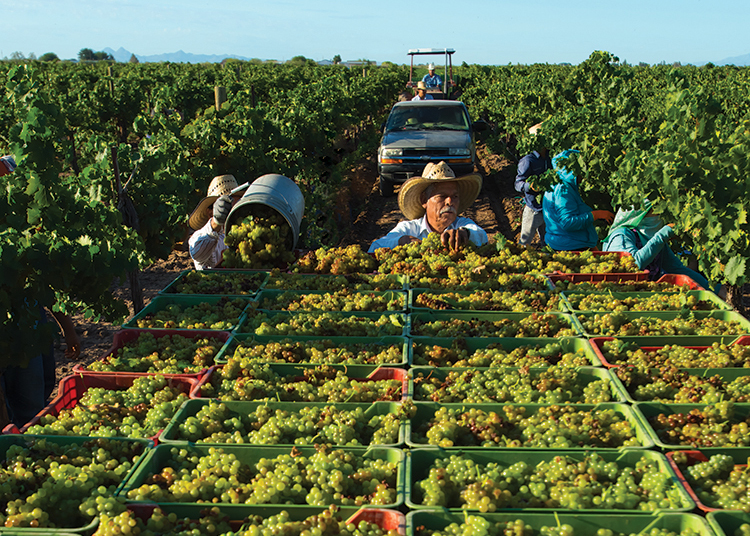Home > New Mexico > New Mexico Agritourism > New Mexico’s Bountiful Beverages
New Mexico’s Bountiful Beverages
In partnership with: New Mexico Department of Agriculture

With the nation’s oldest wine industry and a booming craft beer scene, New Mexicans won’t be going thirsty anytime soon.
Both beer and wine make a significant dent in New Mexico’s economy.
 Steeped in Tradition
Steeped in Tradition
With history dating to the early 1600s, New Mexico calls itself “America’s first wine region.”
“The date we talk about a lot is 1629, which is the first documented grape planting in America,” says Chris Goblet, executive director of the New Mexico Wine and Grape Growers Association. “We had Spanish monks, friars and Catholic missionaries who were coming to the region and planting grapes for sacrament. That was the beginning of the wine industry.”
Today, most of the state’s wine is produced in the southern region, totaling more than 1,500 acres planted with a variety of grapes, including chardonnay, Riesling, zinfandel and more.

Located in the Mimbres Valley in Deming, St. Clair Winery is situated on more than 15 acres. St. Clair is family-owned, with the sixth generation currently running the winery.
“Wine growing and wine making have a long-standing history which has become intertwined with New Mexico’s culture,” says Sandra Pacheco, national sales director for Southwest Wines.
She adds that St. Clair’s wines are unique because all varietals produced are 100 percent New Mexico appellation.
“St. Clair Mimbres Red is frequently the No. 1 red wine blend sold in the state, above national and international brands,” Pacheco says.
The winery’s vineyard is located about 50 miles west of Deming.

In 2016, the vineyard produced an impressive 1,464 tons of grapes, translating into 255,670 gallons of wine. Pacheco says that New Mexico consumers are extremely loyal to local wines, and St. Clair tries to help grow that loyalty with agritourism activities. The winery provides tours of the facility and vineyard, plus has three full-service restaurants and a dedicated tasting room.
“Sharing New Mexico’s wine- growing and wine-making history creates a conversation,” Pacheco says. “Sharing the wine develops the palate, ensuring that the New Mexico wine industry will continue to flourish.”
Paolo and Sylvia D’Andrea also share enthusiasm for New Mexico wine. They founded Luna Rossa Winery in 2001, with two current locations in Deming and Las Cruces. Paolo is a fourth- generation grape grower, born and raised in Italy. He came to New Mexico in 1986 to manage New Mexico Vineyards Inc. Luna Rossa boasts 30 acres of vineyard and also has a pizzeria in Las Cruces, which helps to promote their wines.
![NM alcohol [INFOGRAPHIC]](https://eadn-wc01-4177395.nxedge.io/wp-content/uploads/2020/05/Screen-Shot-2016-12-16-at-1.26.49-PM.jpg) Another winery thrives in New Mexico’s sandy, dry desert region on the outskirts of Albuquerque, producing world-famous sparkling wines. Family-owned and operated, Gruet Winery was founded in 1984 and specializes in Champagne Method sparkling wines, with roots extending back to France. The winery is mostly known for its Brut wine.
Another winery thrives in New Mexico’s sandy, dry desert region on the outskirts of Albuquerque, producing world-famous sparkling wines. Family-owned and operated, Gruet Winery was founded in 1984 and specializes in Champagne Method sparkling wines, with roots extending back to France. The winery is mostly known for its Brut wine.
They also offer wine tours around the production facility and give consumers the opportunity to hand-pick grapes.
Goblet says agritourism opportunities are extremely important for the consumer.
“You’re talking to the winemaker and family members, and that’s a really tangible experience,” he says. “It changes the way a visitor or local thinks about agriculture and the process. It becomes a deeper experience.”
 Brewing Strong
Brewing Strong
The first microbrewery in New Mexico opened in 1988 in Santa Fe, and since then, more than 60 have joined the ranks.
John Gozigian, executive director of the New Mexico Brewers Guild, says the boom in craft breweries is a matter of taste.
“Craft beer tastes better, offers a wide variety of flavors, aromas and characteristics, and is a better value than mass-produced beers,” he says. “Consumers also recognize that locally produced beer is fresher and take pride in supporting their local brewery.”
Gozigian adds that New Mexico breweries are heavily connected to the agriculture industry through spent grains.
“Our breweries generate thousands of pounds of spent barley every day, which is a waste product for us that poses a real challenge,” he says. “Fortunately, spent grains are in high demand as livestock feed.”
Though this livestock-brewery partnership is positive, he says he hopes in the future more breweries will grow their own hops and barley. He wants to see New Mexico-grown barley used to make New Mexico- brewed beer that’s then recycled as feed for New Mexico-raised livestock.
Consumers can explore the state’s beers on the New Mexico Ale Trail, which maps out breweries and events. Gozigian says many breweries also offer regularly scheduled tours.



